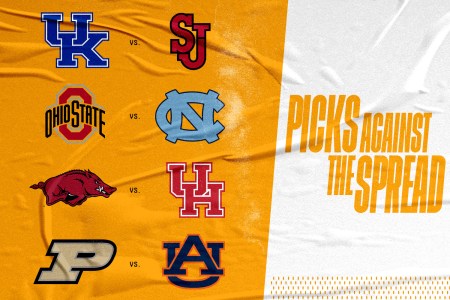On top of describing himself as “super boring,” Ken Pomeroy confesses that he’s terrible at long-range planning. He cites, for example, his decision to major in civil engineering at Virginia Tech, only to discover after graduation that it, too, was super boring. So Pomeroy pivoted to meteorology, but he still had no designs on what would come next. “I was just interested in the weather,” he says. “I kind of like predicting things.”
Pomeroy could hardly have forecast where the winds of change would propel him. Against all odds, without any plans, this mild-mannered, soft-spoken, math-nerding, sports-loving, 51-year-old bachelor has taken the college basketball world by storm. In that world he’s not Ken Pomeroy but rather a superhero named KenPom, the eponymous founder, owner, operator, coder, numbers cruncher and designer of KenPom.com, the sport’s premier analytics website. The site’s impact is so profound that the moniker “KenPom” has become embedded in the vernacular. If you’re a true college basketball fan, you know exactly what it means.
Pomeroy is as surprised as anyone by all that has transpired. “It’s been a very personal journey for sure,” he says from his home in Salt Lake City, Utah. “I never expected this to happen. I wasn’t trying to make it happen. I was just trying to do something that I thought would be cool for people like me.”
Pomeroy’s origin story begins about how you think it would, as a young boy at home in Alexandria, Va., pouring over box scores in an ancient artifact called the local newspaper. Also unsurprisingly, he was a numbers whiz who aced the math section of the SAT. Pomeroy’s childhood heroes weren’t just Michael Jordan and Cal Ripken, but also Bill James, the iconic writer and historian whose “Baseball Abstracts” volumes launched the modern era of sports analytics.
After graduating from Virginia Tech, Pomeroy took a job in Baltimore as a civil engineer. He got weighed down performing mundane tasks like writing environmental impact statements, so he enrolled in a two-year graduate program in meteorology at the University of Wyoming. “If I was going to change careers, I figured I’d go someplace completely new,” he says. “There wasn’t much to do there, but from a meteorology standpoint it was amazing because it has the wackiest weather.”
Upon graduation, Pomeroy took a job with the National Weather Service in Great Falls, Montana. The work was interesting, but the hours were “inhumane.” (Who could have predicted that weather does not take time off?) Still, he remained a sports geek at heart. He remembers growing frustrated while watching an Air Force basketball game and hearing the broadcasters talking about scoring averages without noting that the Falcons played an excruciatingly slow pace. This was in the early days of the internet and Pomeroy noticed that while there was extensive analysis being performed on baseball statistics, there was very little attention being devoted to college basketball. So he started a blog.
For a math maven, Pomeroy is a remarkably eloquent writer. His ability to distill complicated concepts into simple terms helped his essays catch on with a burgeoning community of fans, who discussed his work on message boards and blogs of their own. Pomeroy had no concept of how to create a website. (If he were a better planner, he would have paid closer attention to those programming classes in college). So he set out to learn how to build, code and design a website step by step, which he needed to know for his meteorology work as well. In 2001, KenPom.com was born.
The central concept behind Pomeroy’s interpretation of data is efficiency. It’s not the number of points a team scores that matters most, it’s the number of points per possession. It’s not the number of offensive rebounds, it’s offensive rebound percentage — that is, the number of rebounds collected divided by the number of shots missed. To be sure, Pomeroy didn’t invent these ideas. Dean Smith, who majored in math at Kansas, had his managers at North Carolina track points per possession starting in the early 1960’s. Smith expanded on the concept in his 1981 book, “Basketball: Multiple Offenses and Defense.” In 1985, Jeff Sagarin devised a ratings system for USA Today, but he did not delve into team and player stats. John Gasaway was a forerunner of analytics journalism at ESPN.com. Dean Oliver, a statistician who worked for ESPN.com and later for NBA teams, published a seminal book in 2004 called “Basketball Beyond Paper.”
“It’s the clearest, most unbiased evaluation of your team that you could have.”
-Jay Wright
Since Oliver’s book focused primarily on the NBA, Pomeroy saw an opportunity to own the college space. His genius with numbers is enhanced by a Steve Jobs-like flair for design. While many analytics sites are challenging for the average fan to navigate, KenPom.com provides a seamless, intuitive user experience. Every number is easy to find, read and understand. Even his use of coloring is elite: Green shade for wins, red for losses, dark green for high ratings, bright red for low ones, lighter hues for the in-betweens, and so on. There are referee ratings, games ranked by a “Thrill Score,” player of the year ratings and even a luck metric. Each player also gets the full KenPom treatment. Their national rankings in each category are denoted in red, which makes them easy to discern.
The main hurdle in those early days was the amount of time it took to enter data. As part of his work with the National Weather Service, Pomeroy, who moved to Salt Lake City in 2006, learned to program and write code that would input weather data automatically. This begat a eureka moment: Why not do the same for KenPom? It took a while to write the code and work out the kinks, but in short order Pomeroy had arranged for every box score to load into his site without his having to push a key. Thus did KenPom go from being a high-maintenance operation to a set-it-and-forget-it masterpiece. In other words, the very model of efficiency.

To that point, Pomeroy was not making any money on the site, aside from a few hundred bucks here and there from Google ads. “This goes back to me being unable to make long-term plans,” he says. “I didn’t think it was possible to do it for the money.” In 2011, he put up a paywall. The front page that ranked all the teams and gave their basic information remained free, but if readers wanted to go deeper on each team, it would cost them $20 a year. (He has since raised the rate to $25.)
Pomeroy figured there wouldn’t be many who were willing to pony up, but within weeks he knew he was very wrong. He stayed at the National Weather Service through the 2011-12 season, but a year later he called it quits. Being KenPom became his full-time job.
Among the many pleasant — and unplanned — surprises was the way Pomeroy’s analytics were embraced by the media. Luke Winn, who was then at SI.com and is currently Director of Prospect Strategy for the Toronto Raptors, was among the first to integrate tempo-free stats. Pat Forde and Andy Glocker at ESPN.com did the same. Grant Wahl wrote about Pomeroy for a long feature on efficiency in Sports Illustrated. ESPN’s Fran Fraschilla was among the first broadcasters to regularly talk about the ratings on his game calls. “I used it because it explained analytics in a simple way that I could communicate to the average fan,” Fraschilla says. When Pomeroy heard Dick Vitale say “KenPom,” he was officially through the looking glass.
The advent of KenPom eventually prompted the NCAA men’s basketball committee to scrap the organizing data tool it had been using since 1981, the Ratings Percentage Index (RPI), and come up with a KenPom-like model. Pomeroy was one of the dozen or so experts the NCAA invited to its Indianapolis headquarters to provide advice. The NCAA then worked with Google to develop the NCAA Evaluation Tool (NET), which it began using in the 2021-22 season. There are some subtle differences, particularly in the way they weigh margin of victory, but if you look at the NET on the eve of the NCAA Tournament, you will see that it tracks almost exactly to the KenPom ratings.
Once KenPom.com became fully automated — most days during the season he spends less than an hour working on it — Pomeroy found himself with a lot of extra time on his hands. He had long been fascinated by niche sports like minor league hockey, college lacrosse and high school football. While watching the 2006 Winter Olympics, he got fixated on curling. In 2018, he launched Doubletakeout.com, a site devoted to curling player ratings. (He is quick to point out, by the way, that he is not the KenPom of curling. That would be Gerry Geurts, if you’re wondering.) Nor does Pomeroy plan to try to monetize those ratings anytime soon. “No one would dare pay for that,” he says.
In the college basketball world, however, everyone pays for KenPom. That includes just about every coach. “It’s the clearest, most unbiased evaluation of your team that you could have,” former Villanova coach Jay Wright says. The site has spawned a generation of innovators and imitators. One in particular, BartTorvik.com, has made considerable headway using a layout and color scheme that is almost identical to Pomeroy’s. Then there’s that other vast community that pays verrrrry close attention to this data — the gambling industry. KenPom.com includes score predictions for every game that will be played this season. You don’t have to be a genius to spy the similarities between those predictions and the point spreads that get posted in Vegas.
Pomeroy can get a little prickly (especially in his Twitter feed) when he hears TV broadcasters cite his numbers but not the source. But even when they do, it’s redundant because most of the audience knows exactly where the numbers came from. Last February, CBSSports.com columnist Matt Norlander argued that Pomeroy should be inducted into the Naismith Basketball Hall of Fame as a contributor. “Ken Pomeroy changed the way people look at the game,” ESPN’s Jay Bilas told Norlander. “He’s the Bill James of basketball.”
Pomeroy was flattered by the suggestion. “I had never thought of it, but it would obviously be a tremendous honor,” he says. He is frequently amused by such instances where his status as a niche celebrity crops up. Like the time his Uber driver struck up a conversation about college basketball and asked, “What do you think about Ken Pomeroy?” Or the night the guy managing the sign-in sheet at the bowling alley saw his signature and cracked, “You have a famous name.” Pomeroy only attends a dozen or so basketball games a year through a media credential. When he meets people for the first time, they almost seem surprised that there is an actual person behind KenPom.com.
Is there a life for KenPom beyond KenPom? Pomeroy has spoken with at least one college head coach about joining his staff, but the offer never came. He does some consulting with an NBA team and met with the Atlantic-10 to offer his counsel on scheduling and other data-driven decisions. He has been approached a couple of times by larger media companies to discuss purchasing the site, but those talks didn’t get very far. “I’m not interested in selling anytime soon, but I’d never say never,” he says. “This has been such a personal thing and I don’t want somebody to turn it into crap. So I’m not sure what the end game looks like.”
It somehow adds up that the creator of a famous predictive metric makes no forecasts about his own future. The way Pomeroy figures things, his best play is to keep crunching those numbers and see where the wind blows next.












